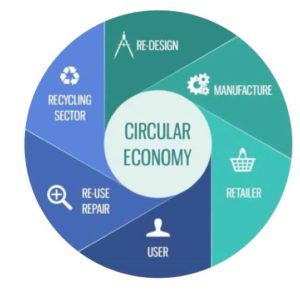DOES CHINA’S EMBRACE OF THE CIRCULAR ECONOMY SET AN EXAMPLE FOR THE WEST?
Innovation is far more than the simple launch of a new product or service that increases the profits of an organisation. Rather, the essence of innovation is to resolve problems – that is, taking action to survive. The emergence of the circular economy fits effortlessly within this more outcome-oriented understanding of innovation. It is an innovation of processes with the clear objectives of keeping our environmental and business ecosystems alive and ensuring a symbiotic existence between industry, consumers and our valuable environment.
THE PLANET: RUNNING OUT OF RESOURCES
Since the beginnings of the First Industrial Revolution, our models of production and consumption have followed the pattern of a linear economy, based on the tryptic of produce, consume, dispose. While this model has enabled the spectacular improvement of living conditions for millions of people in developed countries, its large-scale, negative impact on the environment means that it has very clearly reached its limits. Each year, we get ever-closer to “Earth overshoot day”– or the date where mankind has exhausted the natural resources the Earth is capable of renewing in a year. In 2017, this point of no return was reached on 2 August1. In December of the same year, global consumption surpassed the 70per cent mark of available resources.

THE ADVENT OF THE CIRCULAR ECONOMY
Conscious of the ecological impact of their growth, an increasing number of countries are looking to a new model of consumption and production: the circular economy. This is a system of production which, at every stage of the product lifecycle, aims to increase resource efficiency, lower the impact of the consumer on the environment, and enhance the well-being of humans. First mooted in the 1970s, this economic concept is founded on several green and innovative approaches to production and consumption, such as the sustainable supply chain, eco-design, industrial and area ecology, the product-service system, responsible consumption, extending the duration of product use and recycling. Germany and the Netherlands were among the first in the world to enforce policies aimed at encouraging its implementation, closely followed by Japan. It was during its 12th Five-Year Plan, from 2011 to 2015, that China itself became aware of the impact of its rapid development on the environment and the costs generated by it. In response, the country succeeded in re-thinking its strategy by putting greater emphasis on the development of a sustainable economy. For example, since 2011 large investments have been allocated to environmental conservation through projects aimed at reducing greenhouse gases, increasing forest growth, and creating eco-towns and eco-parks.
THE CIRCULAR ECONOMY IS NOT OPTIONAL
Today, China is one of the rare countries to have adopted a legislation mandating progress and awareness in this area. Its “law for the promotion of the circular economy” has been rolled out widely across the nation, impacting millions across the country. First introduced in 2013, the law proposes that towns and communities work on the post-use reintroduction of natural resources (solids, liquids, gases and organics) in their cycles of production and consumption. It is expected that China will go even further than the other nations committed to the cause by demanding its local authorities revise their regional planning to take this into account. So, while Germany and the Netherlands have made industrial ecology and ecotechnological research a priority, no other country has yet ordered its contracting authorities to make the circular economy a central issue. China has also earmarked a specific budget for this new form of economy. In 2013, 360 billion yuan (over 53.7 billion USD)–from the 52,000 billion yuan (over 7,766 billion USD) in financial credit granted by the major Chinese banks – was dedicated to energyefficient and environmental protection projects, with 63 million yuan specifically allocated for the circular economy2. In addition, China is the first nation to have established circular economy indicators on a macro-economic scale, at both national and provincial levels. More than 80 measurement indicators enable the country to make a clear assessment of its strategy and to set new objectives accordingly. The first results have turned out to be promising. In 2010, 78 per cent of municipal waste produced was sent to the tip, which was reduced to 65per cent in 2014.
BUT IT’S JUST THE BEGINNING…
With emissions that reach 10.357 megatons of CO2 per year, it is important to remind ourselves that China remains the biggest polluter on the planet – well ahead of the United States, whose emissions reach 5.414 megatons. It is also the nation that produces the greatest quantity of greenhouse gases globally, hence the importance of its initiatives around the circular economy. While the country’s numerous projects for more sustainable and ecological growth are to be praised and potentially serve as inspiration for others, there is still a long way to go before we can consider China as a truly eco-responsible country. Only be adopting the circular economy on a larger scale and maintaining its sustainability in the longer term can it become a true agent of change in the years to come. This carries lessons for the rest of the region, too. Asia is without doubt the economy of the 21st century, with stellar growth expected not only in China but also Korea, India, Japan and emerging economies such as Malaysia, Indonesia, and Thailand. At the same time, however, Asia will also be the first in line to suffer the impact of global warming, notably with the rise in the sea level. Countries within the region understand this and are on the lookout for effective and easily implemented models that will enable them to survive. The issue isn’t just felt in Asia though. Western economies are aware of this challenge as well and cannot remain on the side-lines. If globalisation enables us to see the planet as a market, it must also enable us to see it as a place that we must take exceptional care of.
Xavier Pavie
Xavier Pavie is a Pr ofessor at ESSEC Business School, Academic Director of the Grande Ecole programme in Singapore and the iMagination Center. He has recently published L’Innovation à l’épreuve de la philosophie, (PUF 2018) and is notably co-author of the book Responsible Innovation: From Concept to Practice (WorldScientific 2014) and Innovation, creativity and imagination (WorldScientific 2018).
ofessor at ESSEC Business School, Academic Director of the Grande Ecole programme in Singapore and the iMagination Center. He has recently published L’Innovation à l’épreuve de la philosophie, (PUF 2018) and is notably co-author of the book Responsible Innovation: From Concept to Practice (WorldScientific 2014) and Innovation, creativity and imagination (WorldScientific 2018).




